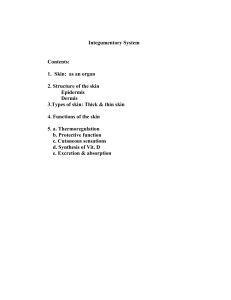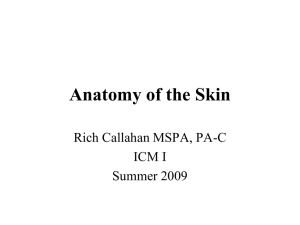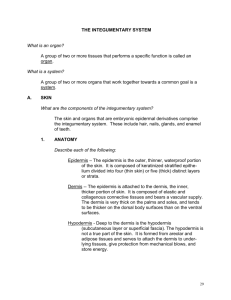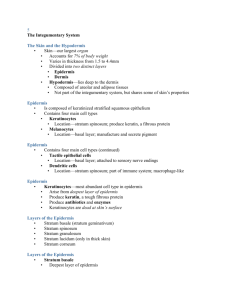Skin Test 101
advertisement
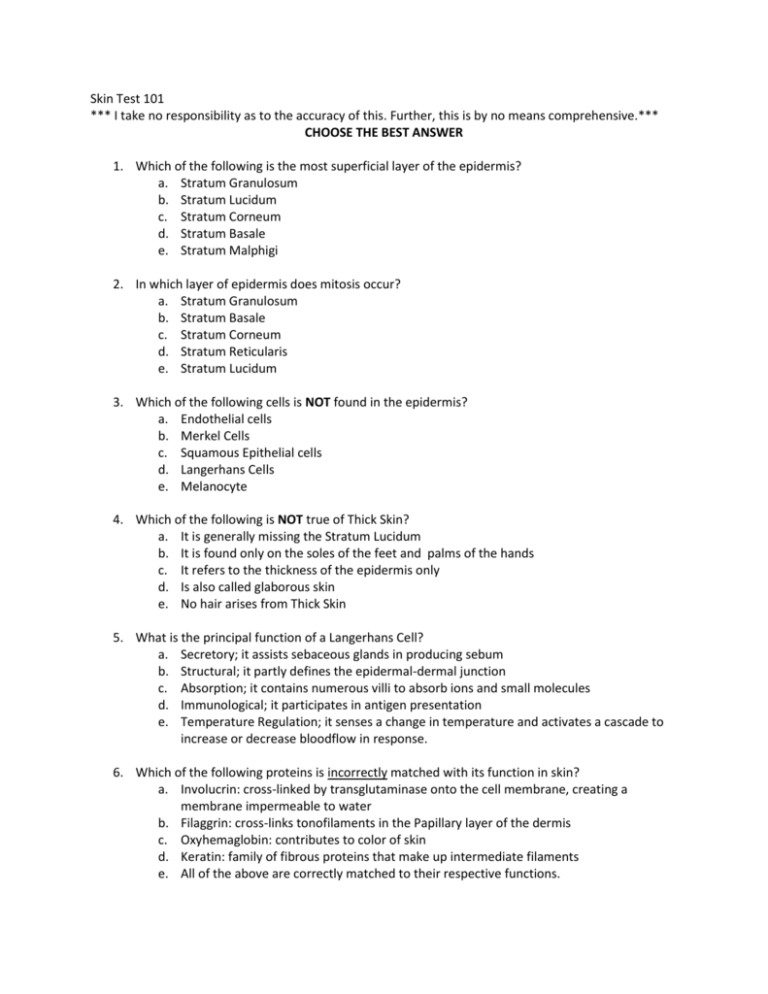
Skin Test 101 *** I take no responsibility as to the accuracy of this. Further, this is by no means comprehensive.*** CHOOSE THE BEST ANSWER 1. Which of the following is the most superficial layer of the epidermis? a. Stratum Granulosum b. Stratum Lucidum c. Stratum Corneum d. Stratum Basale e. Stratum Malphigi 2. In which layer of epidermis does mitosis occur? a. Stratum Granulosum b. Stratum Basale c. Stratum Corneum d. Stratum Reticularis e. Stratum Lucidum 3. Which of the following cells is NOT found in the epidermis? a. Endothelial cells b. Merkel Cells c. Squamous Epithelial cells d. Langerhans Cells e. Melanocyte 4. Which of the following is NOT true of Thick Skin? a. It is generally missing the Stratum Lucidum b. It is found only on the soles of the feet and palms of the hands c. It refers to the thickness of the epidermis only d. Is also called glaborous skin e. No hair arises from Thick Skin 5. What is the principal function of a Langerhans Cell? a. Secretory; it assists sebaceous glands in producing sebum b. Structural; it partly defines the epidermal-dermal junction c. Absorption; it contains numerous villi to absorb ions and small molecules d. Immunological; it participates in antigen presentation e. Temperature Regulation; it senses a change in temperature and activates a cascade to increase or decrease bloodflow in response. 6. Which of the following proteins is incorrectly matched with its function in skin? a. Involucrin: cross-linked by transglutaminase onto the cell membrane, creating a membrane impermeable to water b. Filaggrin: cross-links tonofilaments in the Papillary layer of the dermis c. Oxyhemaglobin: contributes to color of skin d. Keratin: family of fibrous proteins that make up intermediate filaments e. All of the above are correctly matched to their respective functions. 7. Which of the following is TRUE? a. Keratinocytes are derived from the endoderm germ layer b. Melanocytes are derived from the ectoderm germ layer c. Langerhans cells are immotile d. Merkel cells are mechanoreceptors e. NONE OF THE ABOVE are true. 8. Keratinocytes: a. Do not undergo mitosis b. Add to create a waterproof barrier in the dermis c. Are inhibited by dimethyl sulfoxide (DMSO) d. Are derived from ectoderm germ layer e. Have a significant secretory function 9. The waterproof barrier formed in the epidermis is due in part to: a. Impermeability of cells due to build up of keratin b. Thickening of cell membrane due to involucrin c. Presence of glycolipids between keratinocytes d. All of the Above e. None of the Above 10. Which of the following diseases/conditions is due to the excess proliferation of keratinocytes? a. Phemphigus b. Psoriasis c. Eczema d. Squamous Cell carcinoma e. Erythema For Questions 11-12, Refer to the diagram below: 11. Arrow A points to: a. Internal root sheath b. Cortex of the hair root c. Medulla of the hair root d. Bulb of the hair e. External root sheath 12. Arrow B points to: a. Internal root sheath b. Cortex of the hair root c. Medulla of the hair root d. Bulb of the hair e. External root sheath 13. Dimethyl Sulfoxide (DMSO) is hazardous to the skin because a. It inhibits keratinocytes from acting b. It is a penetrating agent of the skin and could transport toxins c. It inhibits development of the Stratum Basale, causing skin to “slough off” d. It is a primary cause of inflammation, indirectly causing arthritis e. It inhibits intracellular proteins, causing a proliferative pathway to remain “turned on” (thus, it is carcinogenic) 14. Which of the following is NOT true? a. The stratum lucidum contains dead keratinocytes b. The stratum granulosum begins the degenerative phase c. The stratum corneum contains sets of cells called “squames” d. The stratum basale is typically the thickest layer of the epidermis e. The stratum spinosum contains cells with visible nuclei 15. Which of the following conditions (I-IV) are primarily due to melanocytes: I. Phemphigus II. Albino III. Nevus IV. Lamellar ichthyosis a. b. c. d. e. I, II & III II only II, III, IV II, III II, IV 16. Which of the following is TRUE? a. The papillary layer is the thickest layer of the dermis b. The hypodermis is where friction ridges are present c. Striae reflect tears in the dermis d. The dermis is unique in that it contains no collagen e. Blood vessels are predominantly present in the epidermis For questions 17-19, please refer to the diagram below: 17. The layer enclosed by the BLACK brackets is derived from a. Endoderm b. Mesoderm c. Ectoderm d. Mesenchyme e. Mucoid 18. A patient presents with edema, exudation & crusting, and severe itching (pruritis). Noticeably, there is significant inflammation to the areas affected. There are no noticeable “scales”, and the skin is staying attached well. The patient seems NOT to have significant loss of fluids. She most likely has: a. Contact dermatitis, affecting the RED-bracketed region only b. Phemphigus, affecting the BLACK-bracketed region only c. Eczema, affecting both the RED and BLACK-bracketed regions d. Eczema, affecting only the RED-bracketed region only e. Psoriasis, affecting RED-bracketed region only 19. The most superficial layer of the RED-bracketed region contains which of the following cells? I. Melanocytes II. Merkel cells III. Endothelial cells IV. Squames V. Functional Keratinocytes a. I, II, IV & V b. I & V c. III, IV d. IV only e. V only 20. Which of the following is NOT involved in the formation of a melanin epidermal unit? a. Tyrosine is converted into melanin via Tyrosinase b. Formation of premelanosomes from the golgi apparatus c. Formation of melanosomes d. Fusion of melanin granules with lysosomes in the keratinocyte e. All of the above are involved in the formation of a melanin epidermal unit. 21. A correct difference between an eccrine sweat gland and an apocrine sweat gland, is that: a. Eccrine sweat glands are less common, located only in the axilla, mons pubis & curcumanal regions; apocrine are much more common. b. Eccrine sweat glands are have a serous type of secretion, whereas apocrine have a mucoserous type c. Eccrine sweat glands begin functioning at puberty, whereas apocrine sweat glands are functional throughout life d. Eccrine sweat glands have a smaller lumen than apocrine sweat glands e. All of the above. 22. Regarding innervations of the skin, which of the following is NOT accurate? a. There are six morphologically distinct types of receptors in the skin b. Merkel cells function as pressure receptors for light touch c. Both Meissner’s and Ruffini’s corpuscles are encapsulated d. Tension is sensed by the Ruffini corpuscle e. All of the above are accurate. 23. The portion of the Fingernail where keratinocytes proliferate is the a. Nail bed b. Nail matrix c. hyponychium d. Lunula e. Nail plate 24. Periderm, refers to: a. The superficial layer of squamous epithelium which forms at 4-5 weeks of development b. The outermost layer of skin under the hyponychium c. The most superficial layer of skin on the eyelid, as it is missing the stratum lucidum d. The intermediate layer of skin formed between the dermis and the hypodermis e. The rarely seen but plausible layer of skin which sometimes appears in thick skin, between the strata granulosum and spinosum 25. A fetus is captured on sonogram at 15 weeks of gestation. We would expect the skin of the fetus to contain: a. A single layer of epiderms, as skin is just now developing and will proliferate later b. A bilayer of epidermis, as the germinal cells have just begun replicating c. Several layers of epidermis, constantly being replaced and expanding, but not yet fully developed d. Normal skin (normal epidermis), with all proper layers being present e. None of the above. 26. Hypertrichosis refers to: a. Excessive hairiness due to conversion of vellus hair to terminal hair by androgens. b. Excessive hairiness due to a compensatory mechanism as sebaceous glands have poorly developed c. Absence of nails causing excessive hairiness in compensation d. Excessive hairiness due to formation of excessive follicles or persistence of hair follicles that normally disappear during development e. Excessive hairiness due to failure of the hair bud to elongate. 27. Which of the following is in the correct order for normal growth (from first to last): a. Anagen, telogen, proliferation b. Anagen, catagen, proliferation c. Catagen, telogen, anagen d. Telogen, catagen, anagen e. Anagen, catagen, telogen 28. Eccrine sweat glands begin forming: a. Around 10-12 wks gestation b. Around 18-20 weeks gestation c. Around 7-8 weeks gestation d. Around 28 weeks gestation e. Around 3-4 weeks gestation 29. The Fingernail plate is first visible at: a. Around 12-14 wks gestation b. Around 18-20 weeks gestation c. Around 7-8 weeks gestation d. Around 27 weeks gestation e. Around 3-4 weeks gestation 30. Migration of keratinocytes from the basement membrane to the center of a wound in epidermial wound healing requires: a. Tyrosinases, to rid melanin of the path toward the wound b. Metalloproteinases, to break hemidesmosomes c. Endothelial growth factors to be secreted by the keratinocytes as they migrate d. B & C e. A, B & C 31. A woman is rushed to the E.R. with burns on her proximal forearms, from a horrible baking accident. You and Dr. House are both present, and while he’s kicking back some Vicodin, you’re evaluating the patient. She presents with extreme pain to the proximal forearms. Upon evaluation, you discover that there is no apparent scarring or charring, but there is some blister formation. Dr. House, finally getting around to seeing the patient, states that the woman has third-degree burns, and demands (1) amputation, and (2) a martini. Setting the ethical issues aside, you: a. Disagree with Dr. House because amputation is cruel and unusual and is never medically relevant b. Disagree with Dr. House because the woman is suffering from first-degree burns c. Disagree with Dr. House because the woman is suffering from second-degree burns d. Disagree with Dr. House because, although the woman has third-degree burns, her pain in the proximal forearm contraindicates amputation e. Always agree with Dr. House, because disagreeing with him will only bring you a sardonic response and will possibly get you fired. 32. The mode of secretion of apocrine and eccrine sweat glands, respectively, are: a. Apocrine, merocrine b. Merocrine, merocrine c. Merocrine, holocrine d. Apocrine, holocrine e. Apocrine, apocrine 33. Hair follicles are found in: a. Thick skin only b. Thin skin only c. Both Thick and Thin Skin d. Neither Thick nor thin skin…their found in the hypodermis e. None of the above. -----------ANSWERS FOLLOW----------- ANSWERS **Numbers parenthetically (#) indicate page of Dr. Crissman’s notes that correlate to correct responses. For some questions, an explanation is given. 1. 2. 3. 4. 5. 6. 7. 8. 9. 10. 11. 12. 13. 14. 15. 16. 17. 18. 19. 20. 21. 22. 23. 24. 25. 26. 27. 28. 29. C (31) B (30) A (28) – Epidermis is avascular A (32) – Thin skin lacks stratum lucidum D (33) B (36) – filaggrin is found in the epidermis, not the dermis. D (33) – Langerhans cells are motile; keratinocytes are derived from ectoderm; melanocytes are derived from neural crest cells. D (33) – Keratinocytes are not located in the dermis; have nothing to do with DMSO; do not secrete significantly (they produce keratin, but it is stored within the cell); Can undergo mitosis (pages 34-35) D (36) B (38) C (Diagrams, pp. 47, 49) E (Best answer; Diagrams pp. 47, 49) B (39) D (30) – S. Basale is a single layer of cells, and thusly cannot possibly the thickest layer D (41-42) – Phemphigus is an autoimmune disease (38); Lamellar ichthyosis is due to hyperkeratinization of the skin (59-60) C (45) – The reticular layer of the dermis is the thickest (28); Friction ridges appear in the epidermis/dermis (43); The dermis has tons of collagen (42-44); Again, epidermis is avascular. D (28) – BLACK brackets indicate DERMIS; Dermis is derived from mesenchyme C (38) – These are the symptoms of Eczema (contact dermatitis shouldn’t produce edema and inflammation). Eczema affects both the RED (epidermis) and BLACK (dermis) layers, as edema and infiltration of WBC’s must come from this layer. Phemphigus is ruled out in that the skin is well intact and fluid retention seems normal (outside of the edema). D (37) – The most superficial layer of the EPIDERMIS is the Stratum Corneum, which contains only dead cells called squames. E (40) D (52-53) E (55) B (53) A (58) C (diagram, page 59) – the single layer ends about 3 weeks; it’s bilayered at 4-5 weeks and replaces from the intermediate layer starting around 11-weeks. This continues until 21 weeks, when a normal stratum corneum is present. D (62) E (50) B (62) A (62) – The plate forms at 11-12 weeks, and is visible at 12-14 weeks on the fingers. 12-14 is the closest correct answer. 30. B (64) – Tyrosinases are irrelevant to this process; Endothelial growth factors are released by platelets during the clot formation phase. They are not involved in the migration phase; if anything, they cause proliferation. It could be argued that they are chemotaxic factor, but still, the answer would be incorrect as keratinocytes do not release growth factors in this process. 31. C (65) – Though Choice E might be correct, for the purpose of this question, the best answer is Choice C. Blistering separates Second-degree burns from First-degree burns. Without skin charring, we cannot call this “third degree”. Amputation is somewhat irrelevant here. 32. B (52-53) – modes of both are merocrine 33. B (32)
